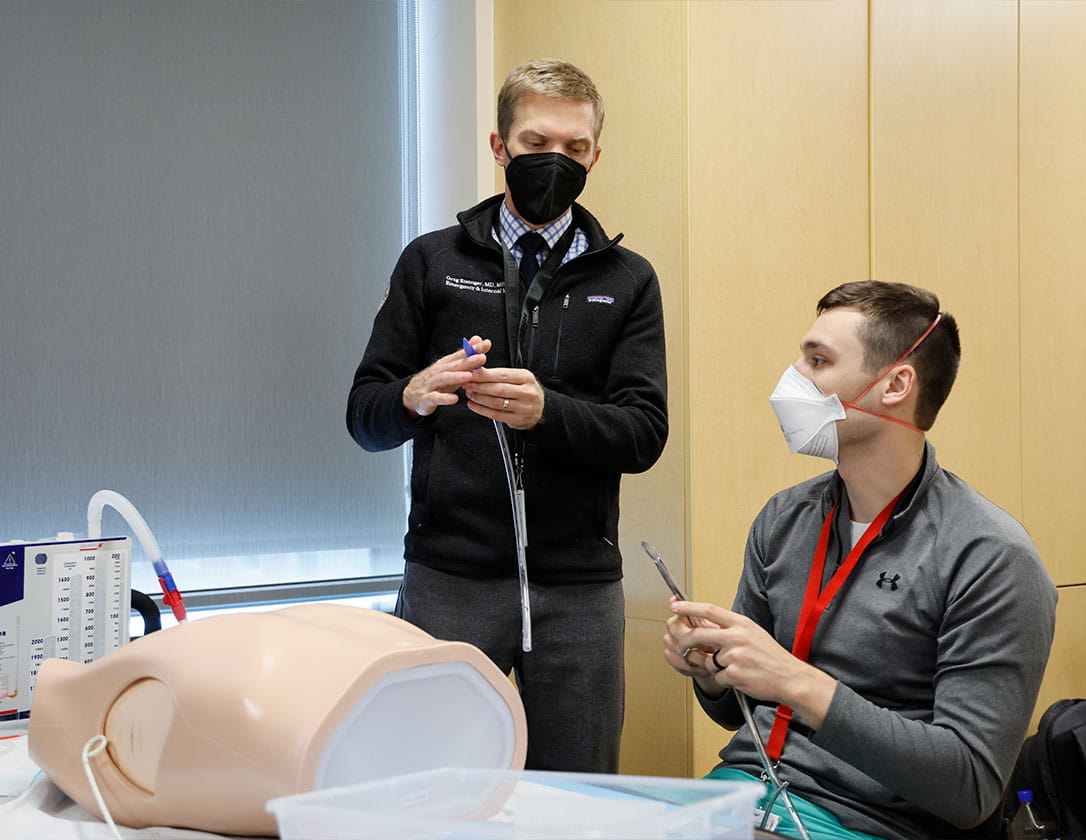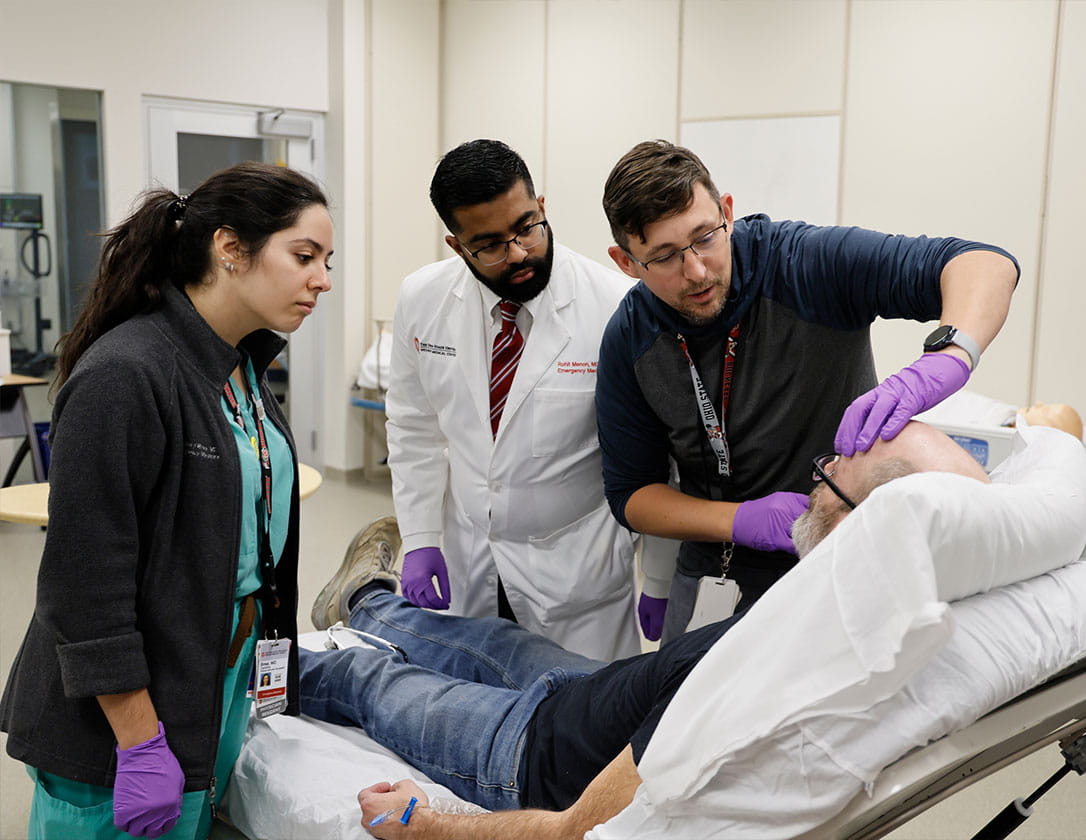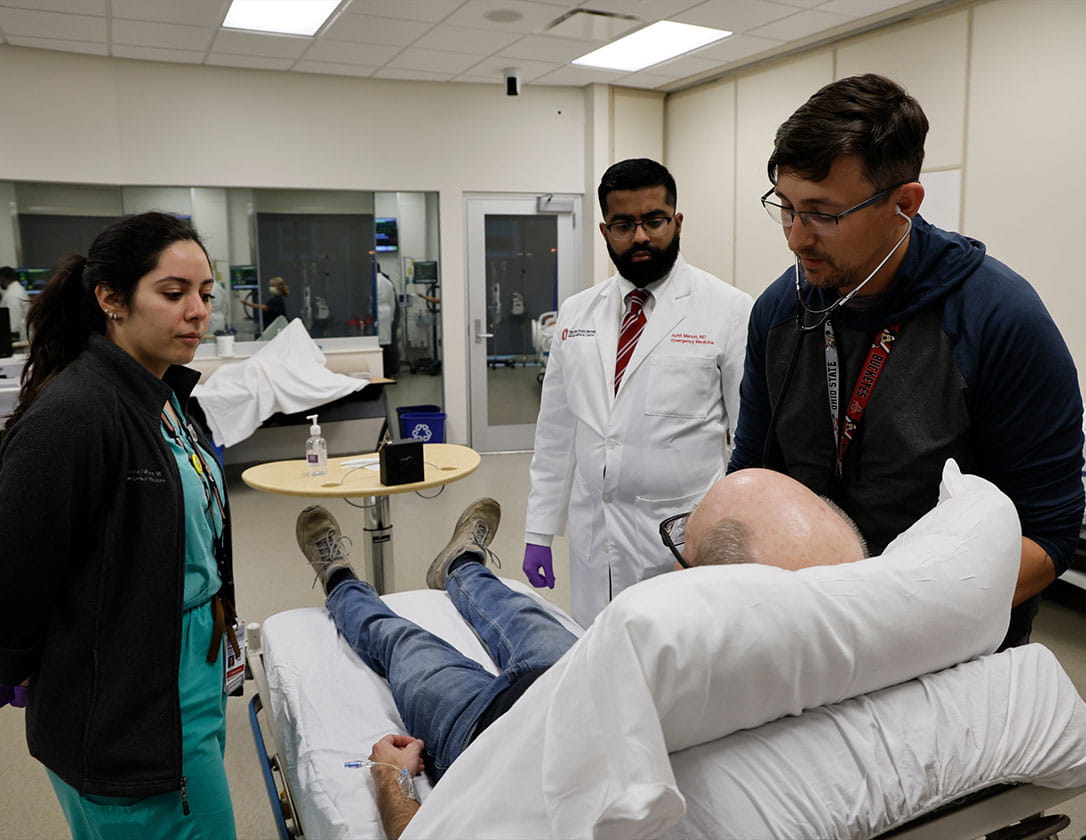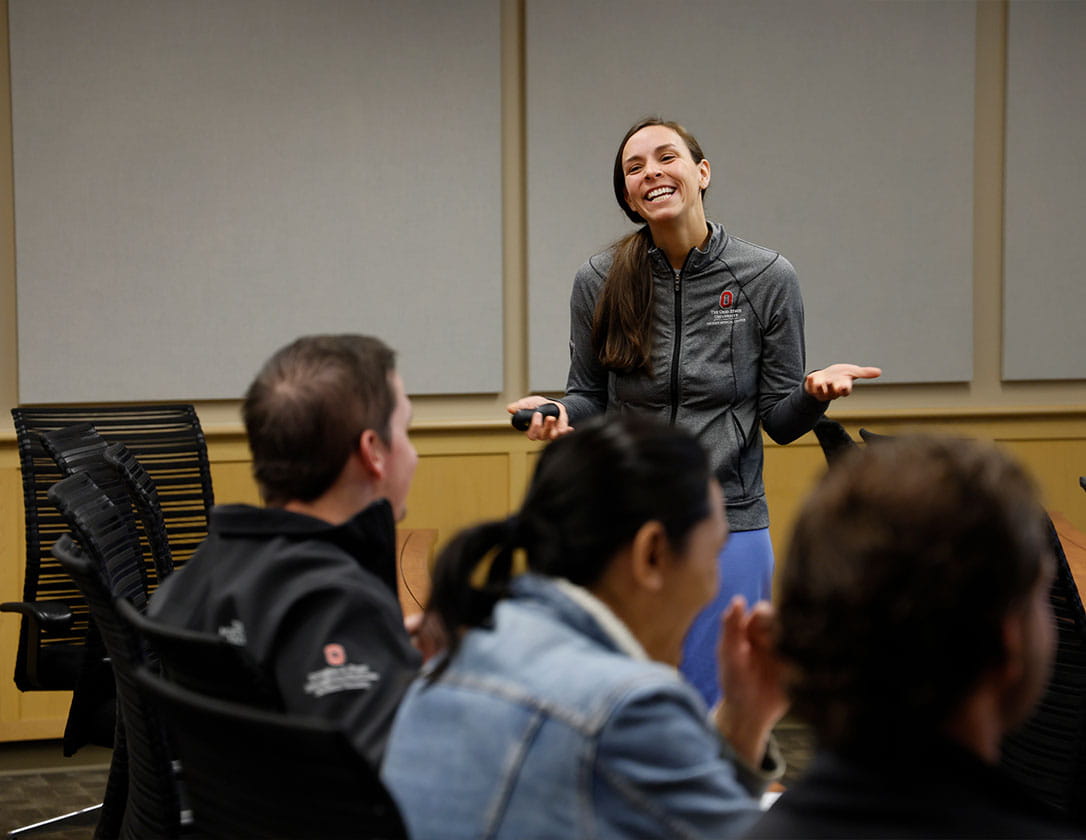Didactics and Conferences
Emergency medicine conferences are attended by education faculty and are considered protected times for residents working in the emergency department and nearly all off-service rotations. Conferences promote self-directed learning using a "flipped classroom" model. In preparation for the weekly small group discussions, residents review various educational resources pertaining to the topics being covered. Small group sessions, which are evidence-based, are led by both emergency medicine education faculty and senior residents. Teaching faculty attempt to maximize the use of technology in both the clinical and didactic settings. Asynchronous learning opportunities exist with FOAMed educational activities, online modules and a question bank available to each resident.
As part of the curriculum, visiting professors of national prominence are invited to share their expertise in specific areas of emergency medicine.
During the first year of residency, additional didactic sessions are scheduled during the month of July to provide an overview of emergency medicine and an orientation to the curriculum. At Ohio State, emphasis is placed on active learning and engaging, thought-provoking educational formats. Longitudinal tracks were implemented in 2016-2017 to further foster residents’ interests in emergency medicine specialty areas and provide career development opportunities.
The Clinical Skills Education and Assessment Center at The Ohio State University Wexner Medical Center is a state-of-the-art training center simulating actual patient care experiences. The facility features patient room encounters, patient models, standardized patients, high-tech patient simulators and electronic monitoring stations. It offers simulated intensive care unit, emergency department and operating rooms, as well as dedicated space for ultrasound training and hands-on procedural training. The center provides exciting opportunities for comprehensive interdisciplinary education. We anticipate continued acquisition of high-fidelity simulators to meet a broad range of educational needs.
Emergency medicine residents participate regularly in simulation and procedural sessions to practice skills pertinent to emergency medicine processes and procedures.
Since 2004, the Center for EMS at The Ohio State University Wexner Medical Center has been dedicated to improving outcomes for cardiac arrest, trauma and other patients in our community. A cooperative effort between the Department of Emergency Medicine, Ohio State's Wexner Medical Center and the Center for EMS (CEMS) seeks to provide an educational and research resource to the central Ohio EMS community. By uniting the efforts of the pre-hospital provider with the hospital-based team, the CEMS is dedicated to providing everyone in the community the best opportunity for survival and improved quality of life.
MedFlight of Ohio is the critical care transport service serving central Ohio and operated by The Ohio State University Wexner Medical Center, Grant Medical Center and Akron General Hospital. Howard Werman, MD, serves as Medflight’s medical director and also is a active member of our OSU emergency medicine faculty. Online medical control for the helicopter and mobile ICU is provided by the emergency department at Ohio State. Residents may also elect to participate in patient transports with the crew of MedFlight and will participate in physician medical direction of the program.
Longitudinal Tracks
Our longitudinal tracks meet once per month for an hour-long session during Wednesday morning didactics. The goal of the critical care track is to provide educational enrichment for residents interested in expanding their knowledge and skills within critical care for any number of reasons. For some, it is just because they love taking care of critically ill patients in the ED and want to become even more expert at doing so or to deepen their understanding of the complex physiology at play in their patients. Others are interested in pursuing fellowship in critical care and also benefit from additional mentoring, brokering relationships with critical care faculty, setting up elective experiences, being connected with research projects, getting help preparing a competitive CV and going through the application process, etc.
What is the focus of the monthly discussions?
The content of our sessions is quite varied but is highly didactic-based. Critical care physicians and track lead, Dr. Greg Eisinger states, “I am a huge physiology nerd and really love taking the journey with our track residents into a deep understanding of physiology and watching the “aha!” moments as they connect concepts that they learned in their preclinical med school courses, or even undergrad physics, with the care that we provide at the bedside in the ICU.” Many of the didactic sessions are lecture based but others are case-based discussions, or rapid fire journal club type format where we discuss important articles that form the core cannon of our current evidence based practice. We also have hands-on sessions where we work on simulation, particularly on bronchoscopy simulator and difficult airway training, as well as “field trip” sessions where we go to the bedside to see the things we’ve discussed in action (such as walking around the MICU and looking at vent tracings or the NCCU looking at EVDs or the CVICU looking at ECMO circuits). We spend much of our time on advanced respiratory failure, ventilator management and shock, but do cover other topics as well. At times we bring in guest speakers to cover specific topics such as ECMO management, ICP management in neuro patients, or transfusion medicine. Lastly, we try to dedicate one session per year to talking about careers in critical care medicine, bringing together panelists who took various pathways through EM to critical care to discuss how they got where they are and what they wished they knew when they were starting.
How to stay engaged
In between our monthly sessions, we stay connected in various ways. Many of our residents work with me on research projects, preparing case reports to submit as abstracts to national meetings, or reach out with various questions about pursuing fellowship. We also have a discussion group on whatsapp that we use to share interesting cases, ask each other clinical questions, share new articles, etc.
It is really a great group and the residents get a ton out of it. Critical care is not the most popular fellowship in EM but we are often one of the most popular tracks because of the content we provide. We have also seen an increase in the number of categorical EM residents going into critical care in the past few years, so in general there are always at least a couple of them in our track, in addition to EM/IM residents of whom many/most pursue some variety of critical care training.
The goal of the EMS track is to help residents develop a better understanding of prehospital care and the unique skill set required to operate within the field. EMS is broad, encompassing many aspects of healthcare, including but limited to medical education, event medicine, disaster, tactical EMS, helicopter EMS, urban search and rescue, research, public health, and administration.
What is the focus of the monthly discussions?
The core content of the EMS track is didactics-based with facilitated opportunities for hands-on experience outside of the monthly meetings. Lectures, case-based discussions, and run reviews touch base on each aspect of EMS, focusing on what residents would do as a medical director and how prehospital care differs from the emergency department. Guest faculty lecturers in a specific subspeciality, such as disaster or research, are invited to add their personal experience and expert knowledge.
How to stay engaged
Residents in the EMS track are provided a list of monthly hands-on EMS activities to pursue at their leisure, including simulation trainings, mass gathering events, research, protocol development, and education opportunities. Notably, residents can be paired with EMS faculty to be an assistant medical director for an EMS agency, allowing a more in-depth experience in a leadership role.
Ultimately, hands-on experiences can be developed based on resident interest, facilitated through the help of faculty. Past opportunities have included disaster training at the FEMA Center for Disaster Preparedness, tactical training at the Muscatatuck Urban Training Center, motorsport medicine at Indianapolis Motor Speedway, and event medicine at OSU football games, the Columbus Marathon, and other sporting events.
Our track is a fantastic place for our educators and interested residents to come together. We meet monthly during conference to share innovative teaching techniques, discuss the latest trends in medical education, and collaborate on strategies to enhance the educational experience for educators and learners in emergency medicine. Our aim is to foster a supportive and dynamic learning environment where we can exchange knowledge, challenge assumptions, and inspire each other to excel in our teaching and educational scholarship endeavors. Our vision is residents prepared to be fantastic teachers and leaders in Med Ed.
What is the focus of the monthly discussions?
The core content of the Med Ed track is formed in collaboration with our participants, with a focus on interactive, hands-on, and case-based learning. Sessions in the past year have explored resources for medical educators, careers in Med Ed, microteaching methods, mentorship, feedback, competency-based education, backward design and learning objectives, podcasting, and tech and AI in medical education. We have opened each session with a “signature bake” teaching tip from our expert educators paired with a themed baked good. We seek to connect residents with further educational opportunities with medical students, residents, research, and national conference presentations.
Our sessions are led by residency program leadership and our medical education fellows, with collaboration with resident leaders on individual sessions. We have high faculty engagement and tend to have similar numbers of faculty and residents present, making this a great way to get to know educational leadership and grow alongside each other.
Ultrasound is a critical skill for emergency physicians. Our program provides excellent training in all recommended applications, and is highly relevant in all longitudinal track applications. It is valuable to the sick patients of critical care and in low-resource settings of global health and wilderness medicine. There are many pre-hospital ultrasound applications in EMS along with the applications in pediatrics. Ultrasound is a teaching skill to build mastery through medical education, and if you are interested in running an ultrasound program, the admin track can help with that! Ultrasound is a constantly evolving field with great research as well.
What is the focus of the monthly discussions?
Track session time provides additional hands-on practice for developing this critical skill with our incredible ultrasound faculty. The content of the ultrasound track is centered around cutting edge concepts such as new uses of ultrasound, TEE, and nerve blocks. We also include evidence-based discussions on recent published literature.
How to stay engaged
There are opportunities for teaching ultrasound utilizing the robust undergraduate ultrasound network, as well as collaboration on ultrasound research projects in the works.
Goals of the track
- Gain confidence in image acquisition skills for core applications
- Learn new indications, procedures, and diagnostic scans
- Gain perspective on the evidence basis for clinical use
- Present ultrasound research nationally
- Become a leader by teaching others
Global Health is defined as an area for study, research, and practice that places a priority on improving health and achieving health equity for all people worldwide. As the safety net of the health care system, Emergency Medicine plays a major role in guaranteeing health equity in the patients that we serve. Emergency Medicine sits at the crossroads between public health and acute clinical care. By nature, emergency physicians are able to ‘think outside of the box.’ Finally, due to flexible scheduling, emergency physicians have played a natural inclination to lead in the area of global health.
Given the ability to treat a wide range of clinical problems, and a familiarity with prehospital and medical emergencies, emergency physicians are well suited to working in a variety of international settings. All of the major organizations (ACEP, AAEM, SAEM) have some formal structure devoted to global (or international) health.
Goals of the Track:
- Provide residents with a foundation in the basic principles of global health
- Provide resident physicians with an appreciation to the broader concepts of health equity and population health
- Present residents with a broad range of experiences to better prepare and enrich their global health experiences
- Participate in a global health or local health care clinic that focuses on health-deficient communities
- Prepare emergency medicine residents to pursue competitive Global Health fellowships
The nature of research requires that the logistics of the resident research longitudinal track will differ from those of the other scholarly tracks. The majority of relevant research skills are best learned via the conduct of the research itself. Many of these skills and techniques, as well as conceptual aspects, will be specific to the resident’s interests and research focus areas. Hence the majority of time in the research track is dedicated to the conduct of the research, rather than in a lecture or meeting format. For example, sessions may be devoted to developing your NIH biosketch, how to submit a survey project to the OSU IRB, or tackling problems in your current research project. The more general research concepts will be taught via a few lectures, participation in journal club, regular meetings with research mentors and research groups, and small group meetings with EM research faculty. Typically only 1-4 residents are in the research track so track faculty can be very focused on your individual success.
To be involved in all parts of a meaningful research project, and to bring that project to completion requires a steady effort throughout the longitudinal track. Ideally, the learner would begin this process midway through their first year by completing a research proposal and IRB application. Any research presentations developed will be supported by the Department of Emergency Medicine.
We have had residents who have done laboratory based research with Dr. Khan’s lab, large dataset studies, clinical research, and cardiac arrest research.
Goals of the Track
- Provide residents with a foundation in the general research concepts necessary for an academic career with a focus on research techniques (including QI, QA, and implementation), clinical translation, and dissemination.
- Provide resident learners with an opportunity to explore in-depth, an area of investigation and discovery that interests them.
- Make resident learners aware of the many career opportunities and benefits that a career in emergency medicine research provides.
The administration track for emergency medicine residents covers a broad spectrum of topics essential for understanding the financial and operational aspects of emergency medicine.
What is the focus of the monthly sessions?
In the first several segments, participants delve into the intricacies of Documentation & Reimbursement, exploring practical strategies to increase RVUs while avoiding over-charting. This includes an analysis of reimbursement disparities between discharged and admitted patients. The session emphasizes prework on charting and coding articles, with a hands-on approach during the meeting where residents collaboratively code prototypical ED provider notes. The discussion may extend to future trends such as value-based payments, distinguishing the implications for independent practitioners versus those working within larger healthcare systems.
The second segment tackles EMTALA, Frequent Utilizers, and Complex Care Plans, highlighting the unique challenges emergency medicine faces in treating all patients and stabilizing conditions. Participants explore prework on EMTALA, engaging in constructing Complex Care Plans for frequent ED utilizers. Considerations extend to the responsibility distribution when acute conditions are missed within the care plan. Payer Mix, Balance Billing, Surprise Billing, and Financial Assistance form the core of the third session, shedding light on the complex financial dynamics from both health system and patient perspectives. Participants are encouraged to read about payer mix challenges specific to the ED setting and understand the nuances of network coverage. The meeting delves into the accounting of ED operations, exploring facility fees and fixed versus variable costs, and may include a review of actual financial statements from OSU ED.
The fourth session focuses on Patient Throughput and ED Metrics, examining common metrics used to evaluate ED performance and strategies for optimization. Participants analyze OSU's metrics, identifying areas of strength and improvement, and exploring cultural barriers affecting patient flow. The fifth session, "Working with APPs," addresses the increasing role of Advanced Practice Providers in emergency medicine. The prework involves understanding the financial benefits of APPs and different staffing models. During the meeting, attendees discuss best practices, workflow patterns, and potentially review OSU financials with respect to APPs. The sixth and seventh sessions cover Financial and Administrative Considerations of an ED Observation Unit and Quality Measurement and Value-Based Payment, respectively, offering insights into the benefits and challenges of observation units and the evolving landscape of value-based payments in the ED. Finally, the eighth session delves into Medicolegal and Regulatory Issues.
The wilderness track is intended for residents with interest in incorporating wilderness medicine into their future careers. The track also welcomes residents who like outside more than inside. The primary objective of the track is to provide residents with specialized wilderness training in order to gain a deeper understanding of wilderness medicine topics and roles as an emergency physician in wilderness medicine. Secondary objectives include supporting residents in pursuing status as Fellows of the Academy of Wilderness Medicine through the Wilderness Medicine Society and to disseminate scholarly wilderness materials, including lectures, review articles, and original research.
Ways to stay engaged
- Presenting wilderness medicine topics at monthly track meetings.
- Help plan and facilitate simulations for the annual residency wilderness conference day.
- Facilitate simulations and present lectures for the OSU medical student wilderness medicine interest group.
- Participate in hyperbaric medicine training.
- Regional and national opportunities for wilderness track residents include:
- Become certified in Wilderness Life Support for Medical Professionals (WLS:MP).
- Become a WLS:MP instructor.
- Become a speaker at the Cuyahoga Valley Regional Medical Conference.
- Attend National Wilderness Medicine Society Conferences (Tahoe, Whistler, Snowmass, Jackson)
- Submit and present 14er talks at National Wilderness Medicine Society Conferences
- Disseminate review articles or original research manuscripts, such as previous OSU publications on altitude illness, bites, stings, and envenomation, and dive medicine.
- Complete a Fellowship in Wilderness Medicine (FAWM), Diploma in Mountain Medicine (DiMM) and/or Diploma in Dive and Marine Medicine (DiDMM).
Pediatric emergencies provoke anxiety even among the most experienced emergency physicians. Critically ill children are considered extremely “high-stakes” cases due to the potential years of life lost. Many physicians also take these cases extremely personal as they have children themselves. Children represent a significant proportion of patients evaluated by emergency physicians, and most pediatric patients will initially be cared for in general emergency departments. Adequate training in routine and emergency pediatric conditions are necessary in the field of emergency medicine.
Ways to stay engaged
In addition to didactics during longitudinal trac time, this track offers the opportunity to shift a small portion of EM shifts from EM to PEM shifts at NCH ED, along with additional access to pediatric anesthesia dates. There are also opportunities for mentored scholarly activities if the resident desires.
Goals of the Track
- Provide residents with educational opportunities related to the care of ill and injured children
- Position learners to enter practice with advanced pediatric emergency medicine knowledge and skills or position them as an ideal candidate for pediatric emergency medicine fellowship
- Develop pediatric patient care skills with increased access to pediatric clinical time including anesthesia or elective opportunities and pediatric emergency medicine didactics


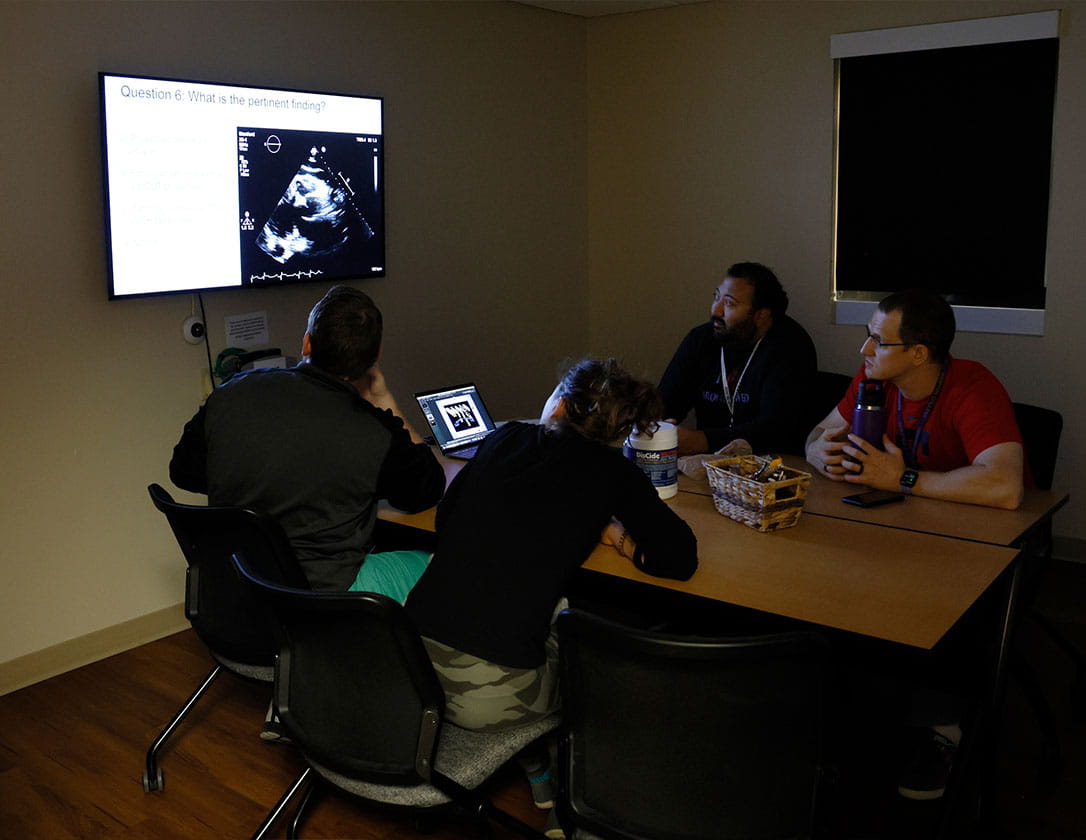

.jpg?la=en&hash=BD5A68A21C43E302E8F890D28229EF60)
.jpg?la=en&hash=0C0A9ECB8577819B6B0C8265B3014001)
